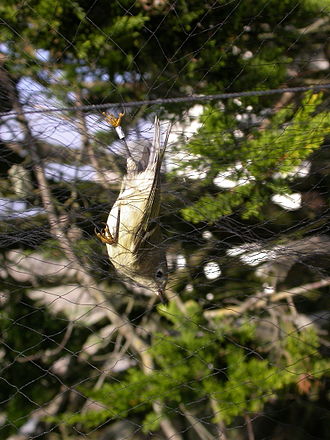AY Honors/Birds - Advanced/Answer Key
Bird ringing (also known as bird banding) is an aid to studying wild birds, by attaching a small individually numbered metal or plastic ring to their legs or wings, so that various aspects of the bird's life can be studied by the ability to re-find the same individual later. This can include migration, longevity, mortality, population studies, feeding behaviour, and many other aspects.

Introduction
Birds are either ringed at the nest, or after being trapped in fine mist nets, Heligoland traps, duck decoys or similar.
A ring of suitable size is attached, and has on it a unique number, plus a contact address. The bird is often weighed and measured, and examined for parasites (which may then be removed) before release. The rings are very light-weight, and have no adverse affect on the birds. The individual birds can then be identified when they are re-trapped, or found dead.
The finder can contact the address on the ring, give the unique number, and be told the known history of the bird's movements.
The organising body, by collating many such reports, can then determine patterns of bird movements for large populations.
The first organised schemes for bird ringing were started (in 1909) by Arthur Landsborough Thomson in Aberdeen and Harry Witherby in England, though smaller individual marking tests had began some years earlier in Denmark and Germany.
Similar schemes
Wing tags
In some surveys, involving larger birds such as eagles, brightly-coloured plastic tags are attached to birds' wing feathers. Each has a letter or letters, and the combination of colour and letters uniquely identifies the bird. These can then be read in the field, through binoculars, meaning that there is no need to re-trap the birds. Because the tags are attached to feathers, they drop off when the bird moults. Imping is the practice of replacing a bird's normal feather with a brightly-colored false feather. A patagial tag is a permanent tag held onto the wing by a rivet punched through the patagium.
Radio transmitters and satellite-tracking
Scientists are now running schemes where minute radio transmitters are attached to the feathers of large migratory birds (geese and swans are popular subjects). These are then tracked by satellites. As with wing tags, the transmitters are designed to drop off when the bird moults.

Field-readable rings
A field-readable is a ring or rings, usually made from plastic and brightly coloured, which may also have conspicuous markings in the form of letters and/or numbers. They are used by biologists working in the field to identify individual birds without recapture and with a minimum of disturbance to their behaviour. Rings large enough to carry numbers are usually restricted to larger birds, although if necessary small extensions to the rings (leg flags) bearing the number allow their use on slightly smaller species. For small species (e.g. most passerines), individuals can be identified by using a combination of small rings of different colours, which are read in a specific order. Most colour-marks of this type are considered temporary (the rings degrade, fade and my be romoved by the birds) and individuals are usually also fitted with a permanent metal ring. In some species where the bird's legs are in water most of the time, such as geese, collars are fitted around the neck.
Other markers
Head and neck markers are very visible. Nasal discs and nasal saddles can be attached to the culmen with a pin looped through the nostrils in birds with perforate nostrils. They should not be used if they obstruct breathing. They should not be used on birds that live in icy climates, as accumulation of ice on a nasal saddle can plug the nostrils. Neck collars made of expandable, non-heat-conducting plastic are very useful for larger birds such as geese.
Some results
An Arctic Tern ringed as a chick not yet able to fly, on the Farne Islands off the Northumberland coast in eastern Britain in summer 1982, reached Melbourne, Australia in October 1982, a sea journey of over 22,000 km (14,000 miles) in just three months from fledging.
A Manx Shearwater ringed as an adult (at least 5 years old), breeding on Copeland Island, Northern Ireland, is currently (2003/2004) the oldest known wild bird in the world: ringed in July 1953, it was retrapped in July 2003, at least 55 years old. Other ringing recoveries have shown that Manx Shearwaters migrate over 10,000 km to waters off southern Brazil and Argentina in winter, so this bird has covered a minimum of 1,000,000 km on migration alone (not counting day-to-day fishing trips). Another bird nearly as old, breeding on Bardsey Island off Wales was calculated by ornithologist Chris Mead to have flown over 8 million km (5 million miles) during its life (and this bird is still alive in 2003, having outlived Chris Mead).
Copeland, ringed 1953
Copeland Bird Observatory
BBC News
Bardsey Island, ringed 1957
Bardsey Island Bird Observatory
BBC News
Wildlife Britain news
Patagial tags in crows
See also
References
- Knox, A.G. 1982. Ringing pioneer. BTO News No. 122, p.8.
- Knox, A.G. 1983. The location of the Ringing Registers of the Aberdeen University Bird-Migration Inquiry. Ringing and Migration 4: 148. (This has a number of additional references.)
